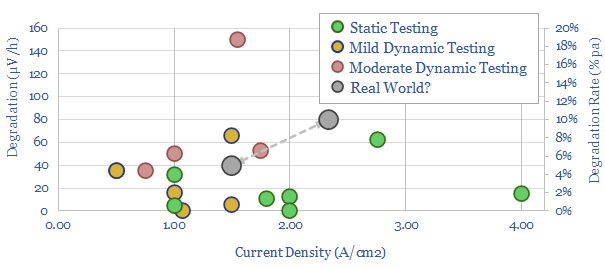What degradation rate is expected for a green hydrogen electrolyser, if it is powered by volatile wind and solar inputs? This 15-page note reviews past projects and technical papers. 5-10% pa degradation rates would raise green hydrogen costs by $1/kg. Avoiding degradation justifies higher capex, especially on power-electronics and even batteries?
The second-by-second output from renewables is volatile. The volatility of solar includes around 100 volatility events per day. The volatility of wind includes around 75 volatility events per day. This is usually fine, as it can be smoothed out in large and diversified power grids, or via different batteries (pages 2-3).
But how can electrolysers run off renewables? This feels like an increasing necessity for green hydrogen, in order to ensure the hydrogen has minimal embedded CO2, and under new requirements from the US Inflation Reduction Act (page 4).
Degradation of electrical equipment under volatile input feeds, including case studies from the motor industry, are reviewed on (page 5).
A brief history of electrolyser and PEM fuel cell deployments are reviewed, in order to draw conclusions on the decline rates of installed systems (pages 6-7).
The technical literature into PEM electrolyser degradation is then reviewed on pages 8-10. We think uncertainty is still high, and it would be helpful to conduct more studies, longer studies and more rugged studies into electrolyser degradation under volatile inputs.
A case study is drawn from the technical literature and described in detail, explaining how dynamic loading has been linked to the degradation of electrolysers. Total stoppages of electrolysers may be a driver of degradation, and require further back-ups (pages 11-13).
Economic implications are spelled out on page 14. As a rule of thumb, adding a 5% pa decline rate to a base case electrolyser model might raise the total levelized cost of hydrogen by around $1/kg.
Can electrolysers run off renewables? Ultimately our answer to this question is yes, but it may require adding power electronics and batteries alongside the electrolysers, in a trade off with up-front capex, in order to mitigate against degradation.
Our roadmap to net zero still sees relatively more potential in large-scale transmission infrastructure, and short-duration battery back-ups, in order to maximize the ascent and impact of renewables.
